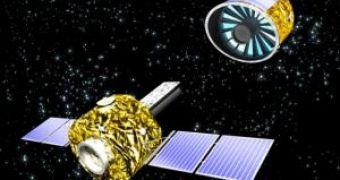A new X-ray telescope is prepared by the European Space Agency, to further study the origins of the Universe. XEUS or X-ray Evolving Universe Spectroscopy aims to study the fundamental laws of the Universe, the formation and evolution of supermassive black holes and the galaxies. XEUS will be 30-50 times more sensitive that the XMM-Newton (X-ray Multi-Mirror Mission), previously launched by the European Space Agency in 1999, and will be placed at a distance of 1.5 million kilometers from Earth in the second Lagrangian point, where it can conduct its observations without being disturbed.
XEUS has been recently selected to take part in the Cosmic Vision program, and will be launched in 2018 with an Ariane 5 rocket. The telescope will be composed of two separate spacecrafts which will fly together, at a distance of 35 - One is used to house the five-meter diameter X-ray lens, and the other will carry the instruments.
The scientists are aiming to use the telescope to analyze X-ray light, to better understand what the conditions in the initial hot Universe were, where the main source of energy was gravity, and in what way matter behaved in such extreme conditions of pressure, temperature and gravity. This crucial information will also give new insight over the influence that black holes exert on the formation of galaxies, stars and planetary systems, and ultimately the origins of life.
The primary optical system is made of lightweight silicon lenses. To study the black holes and the surrounding matter, sensitive sensors must be cooled to very low temperature, close to absolute zero. The detector that includes the wide-field X-ray imaging will have an energy resolution of 150 eV at 6 KeV, and the cryogenic narrow-field imager an energy resolution of 2 eV at 1 KeV.
Several other Space Agencies are willing to cooperate with the European Space Agency, to help in the completion of the XEUS. Other missions candidate to be implemented in ESA's Cosmic Vision program and will participate in a selection programmed for 2009, to be launched in the years 2017 and 2018.
The themes at the basis of the ESA program range from the conditions in which planets are allowed to from around a star, the formation process and the origin of the Solar System, fundamental law of the Universe, the origin, structure and evolution of the Universe we are living in.

 14 DAY TRIAL //
14 DAY TRIAL //